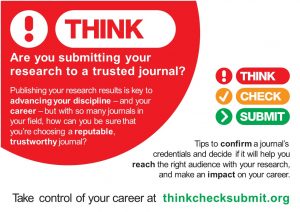Predatory open-access publishing (also known as a type of vanity press) is an exploitative open-access publishing business model that involves charging publication fees to authors without providing the editorial and publishing services associated with legitimate journals (open access or not). The problem of predatory publishers is a relatively recent phenomenon following the advent of the World Wide Web, online publishing, and the call for open-access journals. This allowed for the ability to monetize scientific publishing. This combined with the need for academics to publish has allowed for increasing numbers of publishers to set up solely for making money. Not everything open access is predatory; there are excellent, reputable open-access journals that are indexed and peer-reviewed.
A definition for Predatory journals and publishers:“Predatory journals and publishers are entities that prioritize self-interest at the expense of scholarship and are characterized by false or misleading information, deviation from best editorial and publication practices, a lack of transparency, and/or the use of aggressive and indiscriminate solicitation practices.” (Grudniewicz etal 2019 Nature 576:210-212).
Characteristics associated with predatory open-access publishing include:
- Accepting articles quickly with little or no peer review or quality control, including hoax and nonsensical papers.
- Publish on a vast range of different (unrelated) topics
- Notifying academics of article fees only after papers are accepted.
- Aggressively campaigning for academics to submit articles or serve on editorial boards.
- Flattering e-mail solicitations; official e-mail adddress
- Listing academics as members of editorial boards without their permission, and not allowing academics to resign from editorial boards
- Appointing fake academics to editorial boards.
- Mimicking the name or web site style of more established journals.
- Contact information may or may not be readily available for publisher (Google maps to check out address)
- Making misleading claims about the publishing operation, such as a false location.
- Using ISSNs improperly.
- Citing fake or non-existent impact factors.
Why are predatory publishers a problem:
- little or no peer review
- perpetuates bad research
- limits ability to publish with reputable publishers (sign away copyright)
- can impact career; science may be good but where published hurts
Need help in determining which journals/publishers are predatory and disreputable? Check out the information provided by the library.
ODU subscribes to Cabells Whitelist/blacklist to help you determine those journals with good and bad publishing records. Cabells Blacklist uses various criteria to evaluate journals suspected of deceptive, fraudulent, and/or predatory practices (Criteria)
Think. Check. Submit is a site to help researchers identify trusted journals for their research. It contains a simple checklist researchers can use to assess the credentials of a journal or publisher.
Submit is a site to help researchers identify trusted journals for their research. It contains a simple checklist researchers can use to assess the credentials of a journal or publisher.
Loyola Marymount University and the William H. Hannon Library developed a rubric for the evaluation of journals to assist in determining if a journal is a credible publication through a series of objective measures of credibility. The rubric itself provides useful information; even if you don’t score the paper, it give guidance on the nature of the journal.
Statement on Article Publication Resulting from NIH Funded Research: The National Institutes of Health has noted an increase in the numbers of papers reported as products of NIH funding which are published in journals or by publishers that do not follow best practices promoted by professional scholarly publishing organizations. The NIH indicates predatory journals can be identified by attributes including:
- misleading pricing (e.g., lack of transparency about article processing charges);
- failure to disclose information to authors;
- aggressive tactics to solicit article submissions;
- inaccurate statements about editorial board membership; and
- misleading or suspicious peer-review processes.
Additional information on Predatory Publications/Publishers
- There was an attempt to hijack a journal…
- Predatory journals and Conferences: why fake counts
- A definition for Predatory journals and publishers
- Predatory journals: no definition, no defence
- How to Avoid Predatory Journals When Publishing Your Work
- 6 Questions To Help You Avoid Predatory Publishers
- 8 Ways to Identify a Questionable Open Access Journal
- Identifying Predatory or Pseudo-Journals
- Beall: Essential Information about Predatory Publishers and Journals
- “Predatory” Open Access Publishers – The Natural Extreme of an Author-Pays Model
- ‘Predatory’ Online Journals Lure Scholars Who Are Eager to Publish
- The false academy: predatory publishing in science and bioethics
- Many Academics Are Eager to Publish in Worthless Journals
- Predatory journals recruit fake editor
- This Dog Sits on Seven Editorial Boards